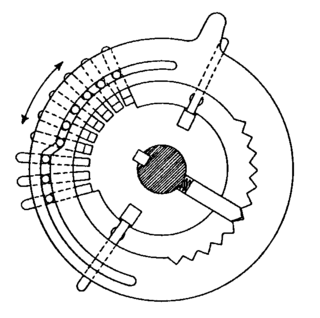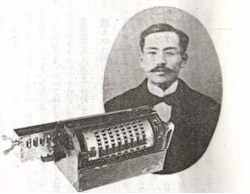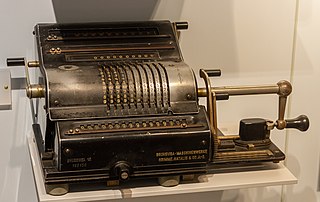
An electronic calculator is typically a portable electronic device used to perform calculations, ranging from basic arithmetic to complex mathematics.

The Curta is a hand-held mechanical calculator designed by Curt Herzstark. It is known for its extremely compact design: a small cylinder that fits in the palm of the hand. It was affectionately known as the "pepper grinder" or "peppermill" due to its shape and means of operation; its superficial resemblance to a certain type of hand grenade also earned it the nickname "math grenade".

The Comptometer was the first commercially successful key-driven mechanical calculator, patented in the United States by Dorr Felt in 1887.

A mechanical calculator, or calculating machine, is a mechanical device used to perform the basic operations of arithmetic automatically, or (historically) a simulation such as an analog computer or a slide rule. Most mechanical calculators were comparable in size to small desktop computers and have been rendered obsolete by the advent of the electronic calculator and the digital computer.
Odhner is a Swedish family. Notable members include:

The arithmometer was the first digital mechanical calculator strong enough and reliable enough to be used daily in an office environment. This calculator could add and subtract two numbers directly and could perform long multiplications and divisions effectively by using a movable accumulator for the result.

Willgodt Theophil Odhner was a Swedish engineer and entrepreneur, working in St. Petersburg, Russia. He was the inventor of the Odhner Arithmometer, which by the 1940s was one of the most popular type of portable mechanical calculator in the world.

Busicom Co., Ltd. was a Japanese company that manufactured and sold computer-related products headquartered in Taito, Tokyo. It owned the rights to Intel's first microprocessor, the Intel 4004, which they created in partnership with Intel in 1970.

A pinwheel calculator is a class of mechanical calculator described as early as 1685, and popular in the 19th and 20th century, calculating via wheels whose number of teeth were adjustable. These wheels, also called pinwheels, could be set by using a side lever which could expose anywhere from 0 to 9 teeth, and therefore when coupled to a counter they could, at each rotation, add a number from 0 to 9 to the result. By linking these wheels with carry mechanisms a new kind of calculator engine was invented. Turn the wheels one way and one performs an addition, the other way a subtraction.
Petters Limited, were a maker of stationary petrol and diesel engines from 1896 onwards. In 1915 Petter founded Westland Aircraft Works. In 1986 Petters Limited merged with one-time rival R A Lister and Company to form Lister Petter.

Charles Xavier Thomas de Colmar was a French inventor and entrepreneur best known for designing, patenting and manufacturing the first commercially successful mechanical calculator, the Arithmometer, and for founding the insurance companies Le Soleil and L'aigle which, under his leadership, became the number one insurance group in France at the beginning of the Second Empire.

The Marchant Calculating Machine Company was founded in 1911 by Rodney and Alfred Marchant in Oakland, California.

Frank Stephen Baldwin was an American who invented a pinwheel calculator in 1875. He started the design of a new machine in 1905 and was able to finalize its design with the help of Jay R. Monroe who eventually bought the exclusive rights to the machine and started the Monroe Calculating Machine Company to manufacture it.

A mechanical computer is a computer built from mechanical components such as levers and gears rather than electronic components. The most common examples are adding machines and mechanical counters, which use the turning of gears to increment output displays. More complex examples could carry out multiplication and division—Friden used a moving head which paused at each column—and even differential analysis. One model, the Ascota 170 accounting machine sold in the 1960s, calculated square roots.

Ryōichi Yazu was a Japanese inventor. He is best known for his invention of Japan's first mechanical calculator.

A Leibniz wheel or stepped drum is a cylinder with a set of teeth of incremental lengths which, when coupled to a counting wheel, can be used in the calculating engine of a class of mechanical calculators. Invented by Leibniz in 1673, it was used for three centuries until the advent of the electronic calculator in the mid-1970s.

The Millionaire was the first commercially successful mechanical calculator that could perform a direct multiplication. It was in production from 1893 to 1935 with a total of about five thousand machines manufactured.
Olympia-Werke AG was an important German manufacturer of typewriters. Since the plant in Roffhausen near Wilhelmshaven was closed in 1991, only the brand name has survived.

Brunsviga is a calculating machine company whose history goes back to 1892 with devices upgrading from mechanical to electrical thereafter. The firm Grimme & Natalis that manufactured the machines changed their name to Brunsviga Maschinenwerke A.G. in 1927.






















